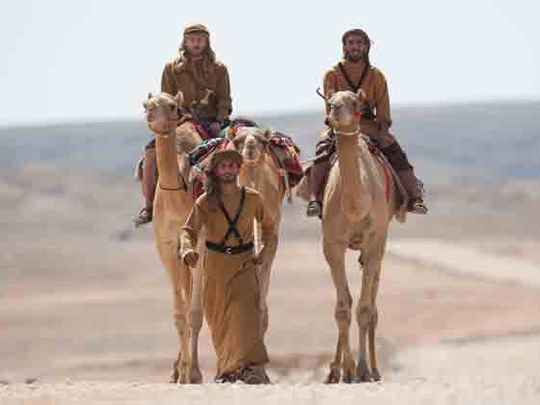
Dubai: When Footsteps of Thesiger, an hour-long documentary commissioned by the Abu Dhabi Media, premieres in the UAE on May 9, the question that will be asked is the authenticity with which three modern-day men have “re-enacted” the great British explorer’s 65-year-old journey in the Empty Quarter.
The camel-in-tow protagonists - Dubai-based adventurer Adrian Hayes and his two Emirati companions Saeed Rashed Al Mesafry and Ghafan Mohammed Al Jabry - donned the traditional dishtash and khanja and survived on dates, rice and bread; they left their cell phones behind and relied on maps and a compass – instead of GPS – to traverse the world’s largest sand desert.
But there was no denying the shifting sands of time: arid grasslands, lack of water, oil installations, rigs, even army camps.
“It’s a reality of where we are now,” said Hayes.
A modern-day expedition, it had its trappings. Permissions to be obtained, re-supplies from four-wheel drives, a film crew in attendance and prior publicity that had crowds pouring in to meet and greet the travellers.
Yet, Hayes said, “My overall impression is that things haven’t changed much over the decades. The culture and way of life is largely unchanged.”
He said the upcoming documentary, produced by TwoFour Productions of the UK, showcases the travels of Sir Wilfred Thesiger and their re-enacted expedition with a focus on the beauty of the desert and the hospitality of the people.
“The Rub’ Al Khali or the Arabian Desert is a beautiful but brutal place. Beautiful because it is largely untouched with its pristine sand dunes, salt plains and its vast nothingness, which has a hynoptic effect. Brutal because the conditions are sparse and harsh. There is no rainfall, no water and temperatures cross 40 degree Celsius,” said Hayes.
The trip, sponsored by the Abu Dhabi Authority for Culture and Heritage, covered a distance of 1,600km from Salalah, Oman to Abu Dhabi in 44 days. In Oman, the trio was accompanied by four Omanis. They trekked through the dry wadis and high dunes of the sand desert for 11-12 hours a day and passed through historical landmarks that Sir Wilfred Thesiger visited during his Arabian travels in 1947. They also covered Umm As Samim, known for its deadly quick sands.
Besides coping with a tough terrain and the harsh climate, Hayes said the biggest challenge was to ensure the camels had enough water and they remained in good shape.











